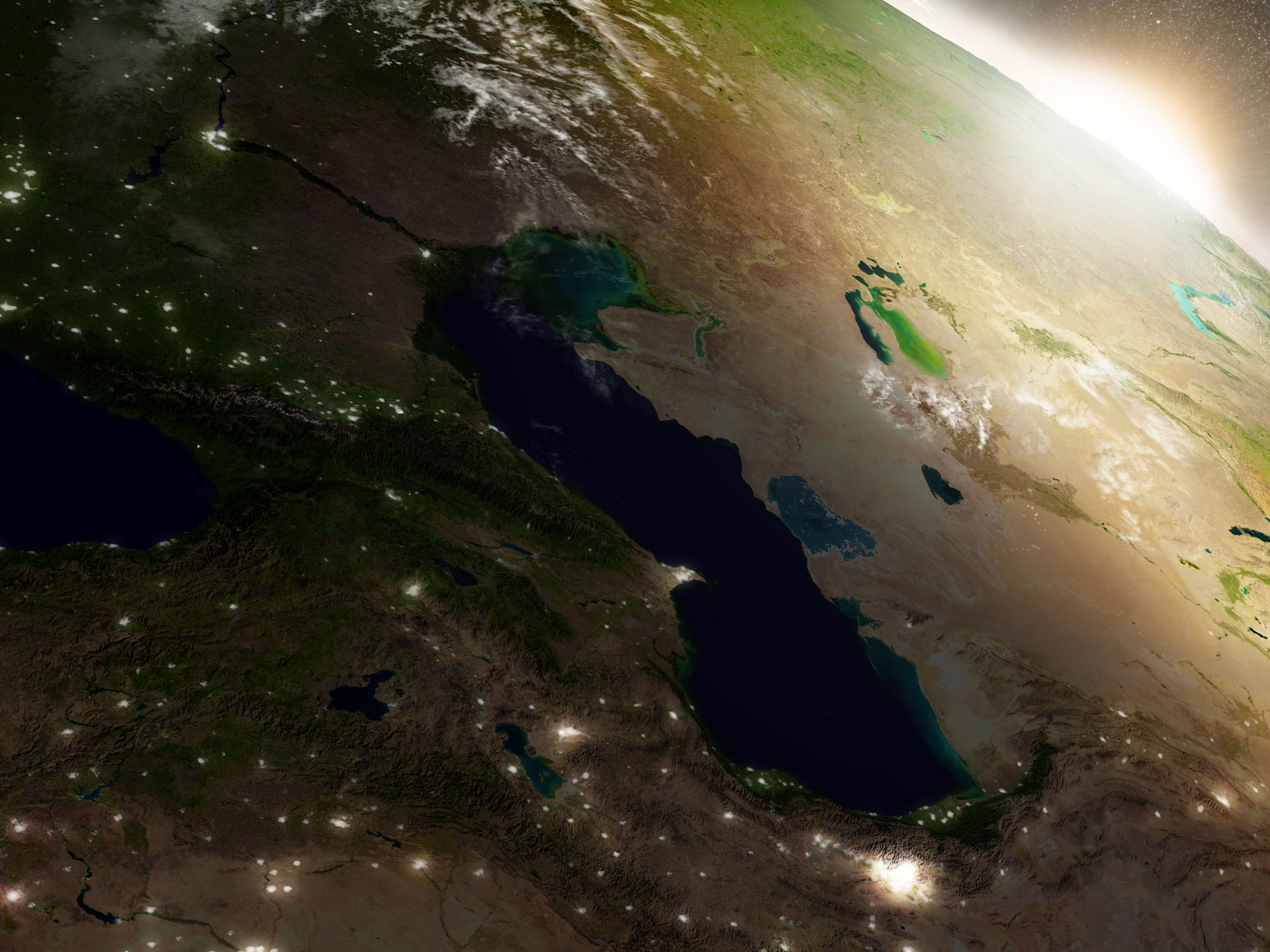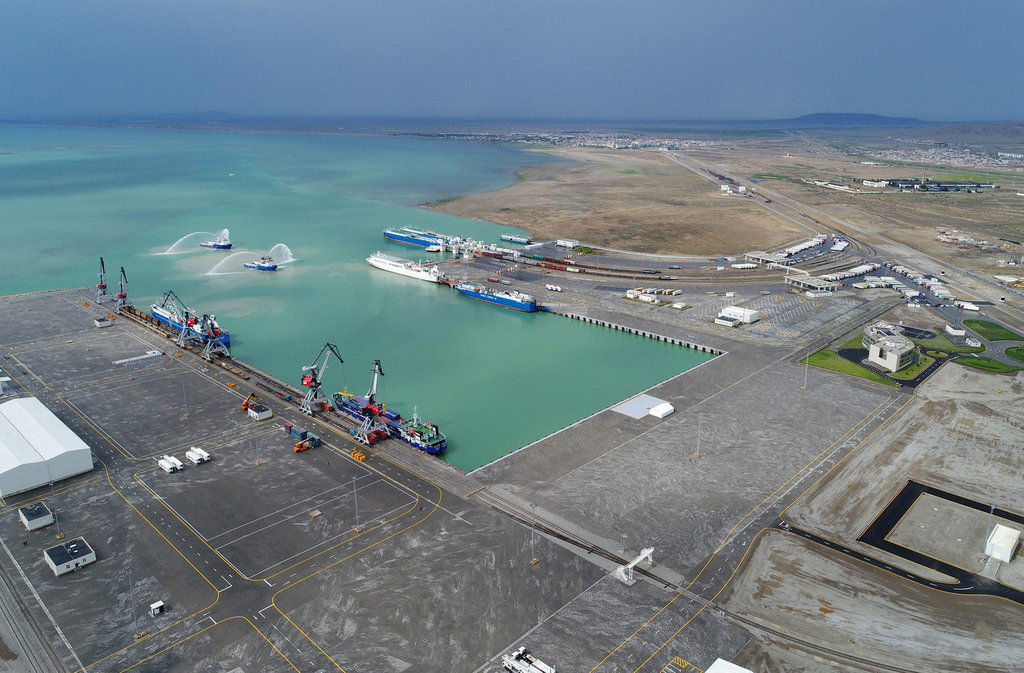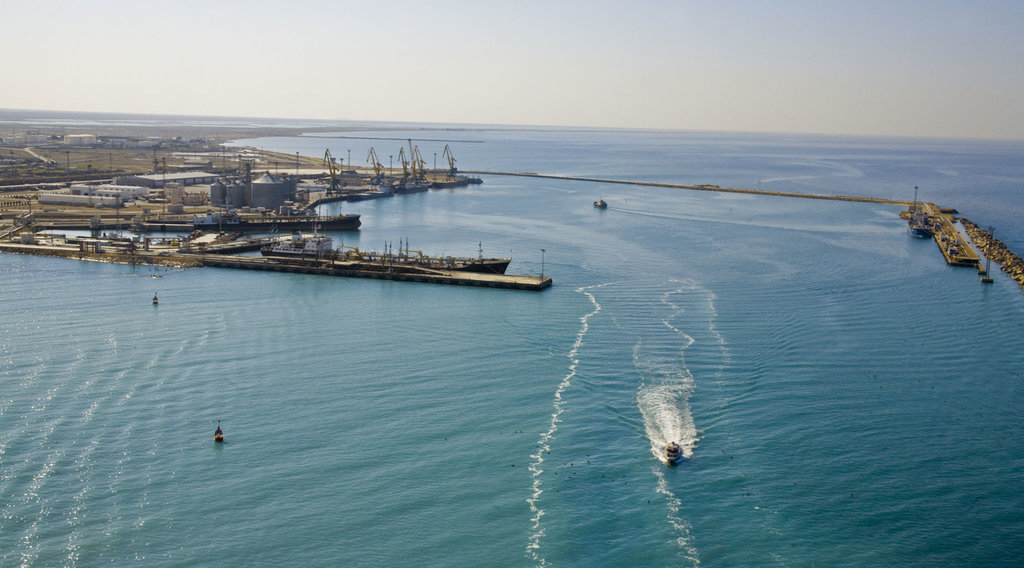Feature
The race to ship in the Caspian Sea
Victor Kotsev highlights five Caspian Sea ports that are flourishing in the wake of the Russian sanctions.

The Caspian Sea is the site of feverish ship and port-building at present. With sanctions over the war in Ukraine hitting hard the traditional trade routes in Central Asia and the Caucasus, all the major players involved – Russia, China, the European Union, and all the countries in the region – are looking for new transportation links.
The largest enclosed body of water on Earth, whose precise status as either a sea or a lake is still debated by scientists, is bounded by Russia and Kazakhstan to the north, Iran to the south, Azerbaijan to the west and Turkmenistan to the east.
This makes it a key part and a major bottleneck of the Middle Corridor – a network of interconnected routes linking China and Europe that avoids Russia, and whose popularity has grown exponentially since the war in Ukraine started.
Prior to the 2022 Russian invasion of Ukraine, over 90% of the rail traffic between Europe and China, as well as the bulk of imports and exports of the Central Asian countries used to run through Russia. Now, a large proportion of that is being redirected over the Middle Corridor, which is shorter, but also less developed and more complex, including a sizable marine component over the Caspian – and, in some of the routes, the Black Sea.
“The further development of the Middle Corridor is very important for several reasons [including that] it will connect Central Asia with the Caucasus and Europe, via Turkey or through the Black Sea, as the only viable trade route to Europe for as long as Russia is under sanctions – or in case of a potential civil war,” says Margarita Assenova, a senior Eurasia expert at US-based thinktank the Jamestown Foundation.
The Caspian Sea: a strategic location
The Black Sea, much of which is currently an area of hostilities, can fairly easily be circumnavigated by east-west traffic since on its southern shore is NATO member Turkey. The Caspian, by contrast, washes on Iranian shores to the south, and Iran, similarly to Russia to the north, is a nation under sanctions.
Until recently, the existence of well-developed rail links from Russia to the west, the so-called Northern Corridor, meant that there was little economic sense in big investments in shipping infrastructure in the Caspian.
That is a major reason why, as recently as 2021, the transport capacity of the Middle Corridor was estimated at only 5% of that of the Northern Corridor. With a big infrastructural expansion underway in the region, that is now changing fast.
Besides the Middle Corridor there is another reason why there is major development all around the Caspian: Russia, cut off from many of its own traditional import and export routes, is eyeing it as a vital link to Iran and to the Persian Gulf. This is part of what analysts are calling Russia’s “pivot to Asia”.
Shipbuilding and maintenance will be a growth industry in the Caspian.
“The Caspian Sea is acting in part as a maritime distribution and logistics hub to all the points on an NSEW compass,” says Chris Devonshire-Ellis, chairman of the pan-Asian business and consulting company Dezan Shira & Associates.
“Shipbuilding and maintenance will be a growth industry in the Caspian [which] is under-serviced in vessels and requires specific designs to cater for its relatively shallow depth, occasional bad weather conditions and the sheer volume of freight needing maritime transport. This will spur a great deal of new shipbuilding activity in the main Caspian shipyards.”
Here are the five key ports in the Caspian Sea where the bulk of recent investments and expansion works are taking place:
Baku Port: Azerbaijan's a gateway to Europe
The Port of Baku, located in Azerbaijan's capital city, is one of the main hubs of the Middle Corridor. Over the past few years, it has undergone a series of extensive expansion projects, including the construction of the New Baku International Sea Trade Port with a Ro-Ro terminal, a logistics centre and a free trade zone, to the cost of at least $1.1bn.
Recently, a fertilizer terminal serving Central Asia’s hydrocarbon exports was also constructed. Currently, its capacity is being increased from 15 million tonnes of cargo per year (mtpa) to 25mtpa, and it connects directly to the Baku–Tbilisi–Kars (BTK) Railroad that allows shipments to reach Europe through Georgia and Turkey in about a week.

An aerial view of Baku International Sea Trade Port is seen after the completion of its 2018 expansion works in Baku, Azerbaijan. Credit: Azerbaijani Presidency/Anadolu Agency/Getty Images
Astrakhan Port: Russia's main hub
While in 2020 Russia announced an intention to invest about $1.6bn in a new Caspian port at the town of Lagan. The port of Astrakhan, situated on the mouth of the Volga River, remains the main Russian outlet to the Caspian.
Moscow is gradually expanding it and planning investments of at least $250m (possibly up to $1bn) in the area by 2026, with the goal of expanding the port’s capacity from 10mtpa to 25mtpa. The endeavour involves the construction of new piers, berths, terminals, and cargo handling equipment.

Port cranes unload a dry cargo ship at Astrakhan Port. Credit: Maykova Galina/Shutterstock
Turkmenbashi Port: Turkmenistan's recent arrival
Turkmenbashi International Seaport, one of the largest ports in the Caspian Sea with a capacity of 17mtpa, serves as a crucial gateway for Turkmenistan's trade with Central Asia. It has close links to Russia’s Astrakhan and recently became a major node in a regional trade route between Kyrgyzstan and Russia that bypasses Kazakhstan.
Turkmenbashi was inaugurated in 2018 and cost $1.5bn to build. It includes a bulk cargo terminal, a ferry terminal, a container terminal, a polypropylene terminal and several oil terminals. Further expansion is expected to increase its capacity to 26mtpa.

Construction of Turkmenbashi Port was scheduled in eight phases on a total site area of 156 hectares. Credit: Türkmendeňizderýaýollary Agency
Aktau Port: the key to Kazakhstan’s oil trade
Kazakhstan's Aktau Port, the largest in the country, plays a vital role in facilitating Kazakhstan’s oil and grain exports to Azerbaijan and Europe, and comprises a key node of the Middle Corridor. It features three dry cargo terminals and three oil terminals and is currently undergoing modernisation worth about $25 million as well as the construction of an additional container hub worth about $29m.
The combined capacity of Aktau port and the smaller and more modern port of Kuryk, which opened in 2018 some 70km to Aktau’s south, is about 20 million tonnes per year. A new grain terminal is expected to start operating later this year at Kuryk, which is being developed as a kind of extension of Aktau, while a new oil terminal is under construction as well.

Aktua Port is an oil and gas hub for the region. Credit: Getty Images
Anzali Port: Iran's bet on both routes
Iran is positioning the Anzali Port, located less than 300km from the capital Tehran, as a sort of alternative to Azerbaijan’s Baku: both as a possible node in the Middle Corridor, transporting Chinese goods shipped through Kazakhstan’s Aktau through Turkey to Europe, and as a vital link to Russia’s Astrakhan.
It includes a free trade zone and has a nominal capacity of 10mtpa. Currently, it is undergoing an expansion worth at least $21m, which will see three new quays built, berths for general cargo, oil and grain, as well as 4,500 tonnes of grain silos.

Anzali port is being positioned as a Baku alternative. Credit: Getty Images
Is Russia losing its grip on the Caspian Sea?
Experts say that development in the Caspian Sea has long been hostage to Russia’s rivalry as a Eurasian trade route, as Moscow retained unofficial veto power over projects in the region after the Soviet Union broke up in 1991.
Now, with Russia’s soft power weakening and China’s soft power growing in the region, and Russia and Iran forging their separate plans for marine development, several powerful geopolitical tides have merged to enable the rise of the Caspian Sea as a major trade and transport hub in Asia.
While directly benefitting from projects such as the Middle Corridor, European and American diplomats have arguably been slow to adapt to these tectonic changes in the region.
“Whether the West, especially the US, going to make Central Asia a priority in its rivalry with China – along with isolating Russia – is yet to be seen,” added Assenova. “The West seems to be late in the game and not as assertive it should be.”